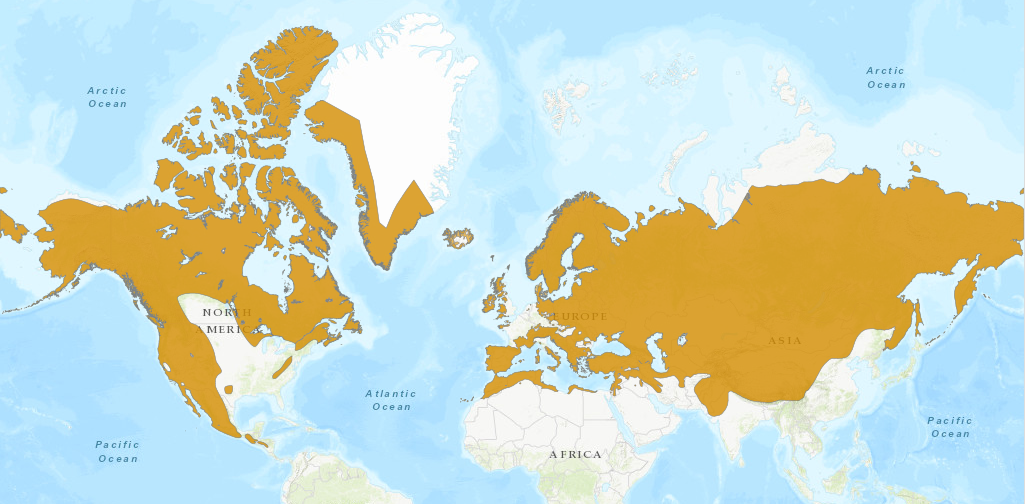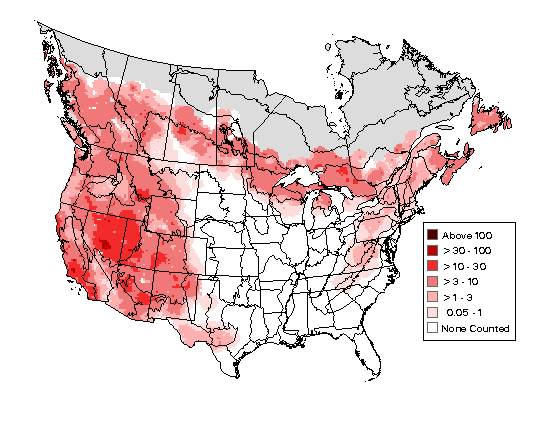Birdfinding.info ⇒ Among the most widely known of all birds, trickster demigod of various myths, icon of the British monarchy and the Baltimore football team, and the titular object of one of the world’s most popular poems. Common in many parts of its extensive range, mostly in desolate landscapes, but uncommon or absent from much of western Europe, eastern Asia, and the eastern U.S. Regions where it is generally common include Alaska, Canada, the western U.S. (see Breeding Bird Survey Abundance Map in Notes below), Mexico, the Iberian Peninsula, heathlands of the British Isles, Scandinavia, and mountainous portions of central and eastern Europe.
Common Raven
Corvus corax
The Northern Hemisphere, in various open and semiopen, but mostly barren and rocky habitats, including arctic tundra, mountains, coastal cliffs, and deserts.
In Eurasia, widespread from the arctic south to the Canary Islands, North Africa (Morocco to Egypt), Jordan, central Iraq, southwestern Iran, western India, the Himalayas, central China, Sakhalin, Kamchatka, and the Kurile Islands. Rare in winter to Hokkaido.
In the Americas, widespread throughout Alaska and Canada south in the west through the U.S. and Mexico to Nicaragua, and south in the east to the Great Lakes, New England, and in the Appalachians to northern Georgia.
An individual that strayed to Kure Island in Hawaii’s Northwest Chain (February 12 – March 21, 2014) appeared large and large-billed, indicating that it likely originated from Asia.
Identification
A large, all-black crow with a massive bill. The largest passerine, up to 70 cm in length and 1.5 m in wingspan.
Apart from size, it can often be distinguished from most similar crows by its flight silhouette: a long, somewhat wedge-shaped tail, and proportionately long, thin wings that it often holds bent at the wrist.
The bill generally appears longer, and often larger overall, than the head. There is some variation, as European populations seem to have larger, deeper bills than North Americans.

Common Raven. (Old Faithful, Yellowstone National Park, Wyoming; June 19, 2018.) © Dave Bengston
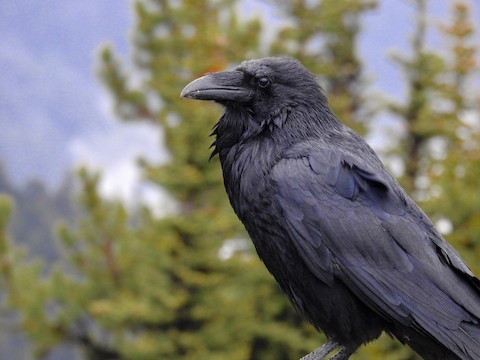
Common Raven. (Manning Provincial Park, British Columbia; June 16, 2018.) © Kalin Ocaña
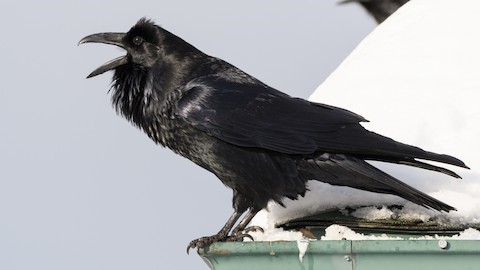
Common Raven. (Ashton, Idaho; January 18, 2020.) © Darren Clark
The Raven
Once upon a midnight dreary, while I pondered, weak and weary,
Over many a quaint and curious volume of forgotten lore—
While I nodded, nearly napping, suddenly there came a tapping,
As of some one gently rapping, rapping at my chamber door.
“’Tis some visitor,” I muttered, “tapping at my chamber door—
Only this and nothing more.”
Ah, distinctly I remember it was in the bleak December;
And each separate dying ember wrought its ghost upon the floor.
Eagerly I wished the morrow—vainly I had sought to borrow
From my books surcease of sorrow—sorrow for the lost Lenore—
For the rare and radiant maiden whom the angels name Lenore—
Nameless here for evermore.
And the silken, sad, uncertain rustling of each purple curtain
Thrilled me—filled me with fantastic terrors never felt before;
So that now, to still the beating of my heart, I stood repeating
“’Tis some visitor entreating entrance at my chamber door—
Some late visitor entreating entrance at my chamber door;—
This it is and nothing more.”
Presently my soul grew stronger; hesitating then no longer,
“Sir,” said I, “or Madam, truly your forgiveness I implore;
But the fact is I was napping, and so gently you came rapping,
And so faintly you came tapping, tapping at my chamber door,
That I scarce was sure I heard you”—here I opened wide the door;—
Darkness there and nothing more.
Deep into that darkness peering, long I stood there wondering, fearing,
Doubting, dreaming dreams no mortal ever dared to dream before;
But the silence was unbroken, and the stillness gave no token,
And the only word there spoken was the whispered word, “Lenore?”
This I whispered, and an echo murmured back the word, “Lenore!”—
Merely this and nothing more.
Back into the chamber turning, all my soul within me burning,
Soon again I heard a tapping somewhat louder than before.
“Surely,” said I, “surely that is something at my window lattice;
Let me see, then, what thereat is, and this mystery explore—
Let my heart be still a moment and this mystery explore;—
’Tis the wind and nothing more!”
Open here I flung the shutter, when, with many a flirt and flutter,
In there stepped a stately Raven of the saintly days of yore;
Not the least obeisance made he; not a minute stopped or stayed he;
But, with mien of lord or lady, perched above my chamber door—
Perched upon a bust of Pallas just above my chamber door—
Perched, and sat, and nothing more.
Then this ebony bird beguiling my sad fancy into smiling,
By the grave and stern decorum of the countenance it wore,
“Though thy crest be shorn and shaven, thou,” I said, “art sure no craven,
Ghastly grim and ancient Raven wandering from the Nightly shore—
Tell me what thy lordly name is on the Night’s Plutonian shore!”
Quoth the Raven “Nevermore.”
Much I marvelled this ungainly fowl to hear discourse so plainly,
Though its answer little meaning—little relevancy bore;
For we cannot help agreeing that no living human being
Ever yet was blessed with seeing bird above his chamber door—
Bird or beast upon the sculptured bust above his chamber door,
With such name as “Nevermore.”
But the Raven, sitting lonely on the placid bust, spoke only
That one word, as if his soul in that one word he did outpour.
Nothing farther then he uttered—not a feather then he fluttered—
Till I scarcely more than muttered “Other friends have flown before—
On the morrow he will leave me, as my Hopes have flown before.”
Then the bird said “Nevermore.”
Startled at the stillness broken by reply so aptly spoken,
“Doubtless,” said I, “what it utters is its only stock and store
Caught from some unhappy master whom unmerciful Disaster
Followed fast and followed faster till his songs one burden bore—
Till the dirges of his Hope that melancholy burden bore
Of ‘Never—nevermore’.”
But the Raven still beguiling all my fancy into smiling,
Straight I wheeled a cushioned seat in front of bird, and bust and door;
Then, upon the velvet sinking, I betook myself to linking
Fancy unto fancy, thinking what this ominous bird of yore—
What this grim, ungainly, ghastly, gaunt, and ominous bird of yore
Meant in croaking “Nevermore.”
This I sat engaged in guessing, but no syllable expressing
To the fowl whose fiery eyes now burned into my bosom’s core;
This and more I sat divining, with my head at ease reclining
On the cushion’s velvet lining that the lamp-light gloated o’er,
But whose velvet-violet lining with the lamp-light gloating o’er,
She shall press, ah, nevermore!
Then, methought, the air grew denser, perfumed from an unseen censer
Swung by Seraphim whose foot-falls tinkled on the tufted floor.
“Wretch,” I cried, “thy God hath lent thee—by these angels he hath sent thee
Respite—respite and nepenthe from thy memories of Lenore;
Quaff, oh quaff this kind nepenthe and forget this lost Lenore!”
Quoth the Raven “Nevermore.”
“Prophet!” said I, “thing of evil!—prophet still, if bird or devil!—
Whether Tempter sent, or whether tempest tossed thee here ashore,
Desolate yet all undaunted, on this desert land enchanted—
On this home by Horror haunted—tell me truly, I implore—
Is there—is there balm in Gilead?—tell me—tell me, I implore!”
Quoth the Raven “Nevermore.”
“Prophet!” said I, “thing of evil!—prophet still, if bird or devil!
By that Heaven that bends above us—by that God we both adore—
Tell this soul with sorrow laden if, within the distant Aidenn,
It shall clasp a sainted maiden whom the angels name Lenore—
Clasp a rare and radiant maiden whom the angels name Lenore.”
Quoth the Raven “Nevermore.”
“Be that word our sign of parting, bird or fiend!” I shrieked, upstarting—
“Get thee back into the tempest and the Night’s Plutonian shore!
Leave no black plume as a token of that lie thy soul hath spoken!
Leave my loneliness unbroken!—quit the bust above my door!
Take thy beak from out my heart, and take thy form from off my door!”
Quoth the Raven “Nevermore.”
And the Raven, never flitting, still is sitting, still is sitting
On the pallid bust of Pallas just above my chamber door;
And his eyes have all the seeming of a demon’s that is dreaming,
And the lamp-light o’er him streaming throws his shadow on the floor;
And my soul from out that shadow that lies floating on the floor
Shall be lifted—nevermore!
Edgar Allan Poe, January 1845
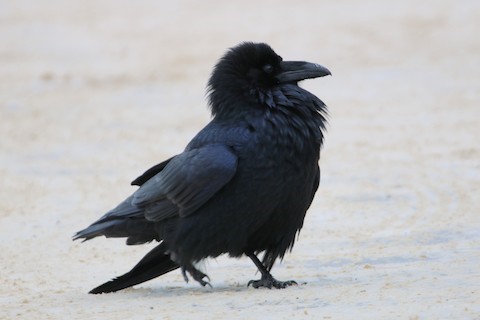
Common Raven. (Spray River Trail, Banff National Park, Alberta; November 18, 2018.) © Plamen Peychev
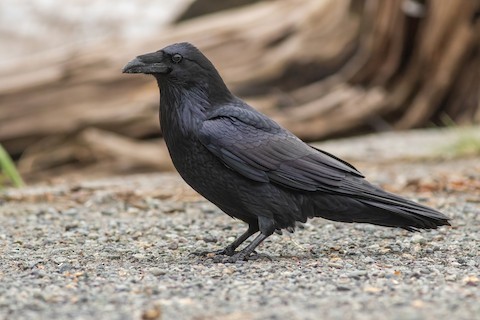
Common Raven. (Kitimat, British Columbia; October 29, 2020.) © Joachim Bertrands

Common Raven. (Bosque del Apache National Wildlife Refuge, New Mexico; November 3, 2017.) © Juan Miguel Artigas Azas

Common Raven. (Antelope Island State Park, Utah; March 13, 2020.) © William Richards

Common Raven. (Cypress Provincial Park, West Vancouver, British Columbia; December 10, 2018.) © Mark Daly

Common Raven. (Ronda, Málaga, Andalucía, Spain; May 4, 2017.) © Santiago Caballero Carrera
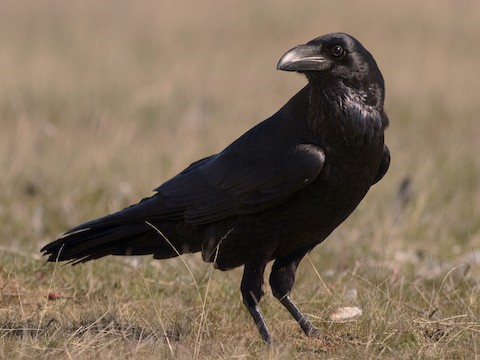
Common Raven. (San Pascual, Castilla y León, Spain; March 29, 2017.) © Juan Parra Caceres

Common Raven, showing a bluish and purplish sheen. (Algonquin Provincial Park, Ontario; November 5, 2020.) © Blair Dudeck

Common Raven, showing the nasal bristles laying flat over the base of the culmen. (Spray River Trail, Banff National Park, Alberta; November 18, 2018.) © Plamen Peychev

Common Raven. (El Codó, Lleida, Cataluña, Spain; January 19, 2021.) © Marc Gálvez
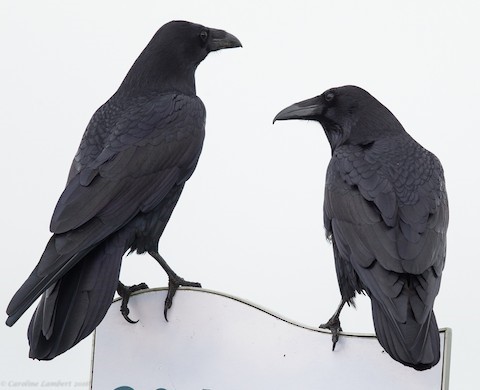
Common Raven. (Seal Point Park, San Mateo, California; January 16, 2016.) © Caroline Lambert
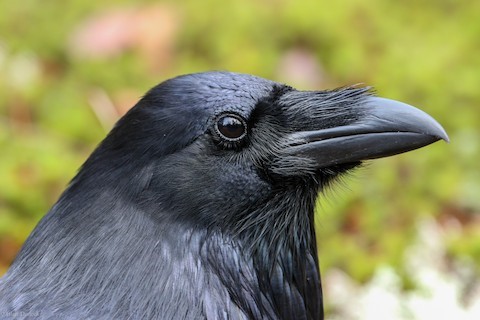
Common Raven. (Algonquin Provincial Park, Ontario; November 5, 2020.) © Blair Dudeck
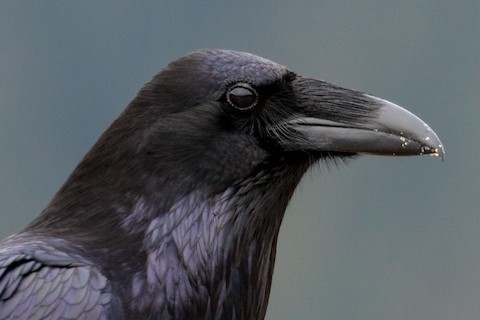
Common Raven. (Pitt Meadows, British Columbia; June 13, 2017.) © John Reynolds
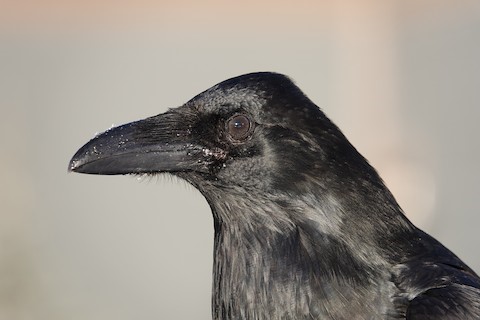
Common Raven. (Quartz Road Marsh, Whitehorse, Yukon; December 28, 2019.) © Cameron Eckert
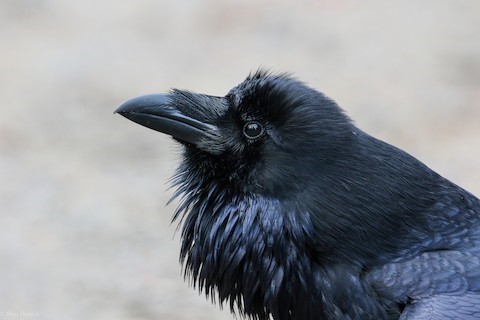
Common Raven, showing shaggy throat and neck feathers. (Algonquin Provincial Park, Ontario; November 5, 2020.) © Blair Dudeck
Immatures have brownish tones over a variable extent of their plumage, most consistently on the head, neck, and body.

Common Raven, juvenile. (Tatra National Park, Poland; June 25, 2020.) © Alexander Hagge
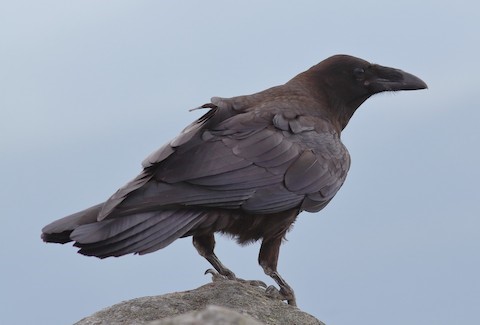
Common Raven, juvenile. (Mount Washington, New Hampshire; July 5, 2019.) © Matthew Bowman

Common Raven, juvenile. (Prince George, British Columbia; June 14, 2019.) © Jeff Dyck

Common Raven, juvenile. (Mount Washington, New Hampshire; July 5, 2019.) © Matthew Bowman

Common Raven, juvenile. (Mount Washington, New Hampshire; July 5, 2019.) © Matthew Bowman

Common Raven, juvenile. (Bujaraloz, Zaragoza, Aragón, Spain; July 11, 2018.) © Arnau Guardia

Common Raven, juvenile. (Alinya, Lleida, Cataluña, Spain; April 28, 2017.) © Ellen Askum

Common Raven, juvenile. (Lambly Lake, British Columbia; July 14, 2020.) © Brad Vissia

Common Raven. (El Codó, Lleida, Cataluña, Spain; January 19, 2021.) © Marc Gálvez

Common Raven. (West Yellowstone, Montana; January 12, 2020.) © Christian Hagenlocher

Common Raven—when folded, the tail appears long and wedge-shaped. (Gilbert, Arizona; May 10, 2018.) © Sean Fitzgerald

Common Raven, showing fairly typical flight silhouette—note especially the proportionately long wings. (Long Pond State Forest, New York; November 26, 2015.) © Chris Wood
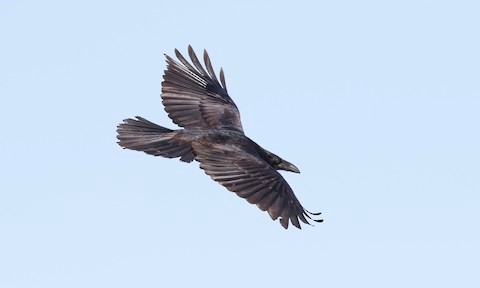
Common Raven. (Summit Ledges, Hawk Ridge Nature Reserve, Minnesota; October 20, 2016.) © Brian Sullivan

Common Raven, juvenile. (North Hero, Vermont; August 9, 2019.) © Jared Keyes

Common Raven. (Cap Tourmente National Wildlife Area, Quebec; January 8, 2021.) © Daniel Campeau
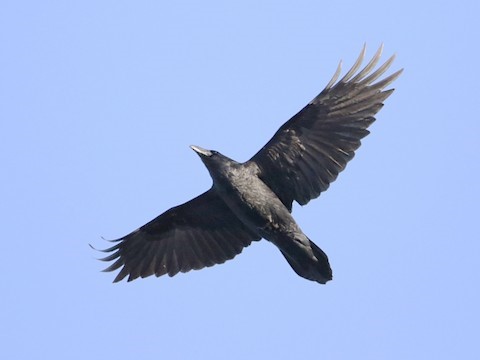
Common Raven. (Sknyatino, Tverskaya Oblast, Russia; February 23, 2017.) © Pavel Parkhaev
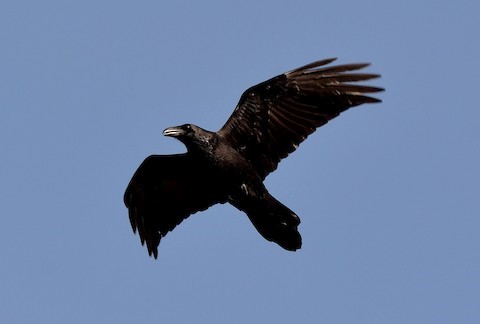
Common Raven, flying with wings bent at the wrist. (Lac-Boivin Nature Center, La Haute-Yamaska, Quebec; November 9, 2019.) © Tom Long

Common Raven, showing characteristically long, wedge-shaped tail. (Summit Ledges, Hawk Ridge Nature Reserve, Minnesota; October 20, 2016.) © Brian Sullivan

Common Raven, showing wedge-shaped tail. (The Bluff, St. Joseph, Ontario; October 9, 2020.) © Brandon Holden
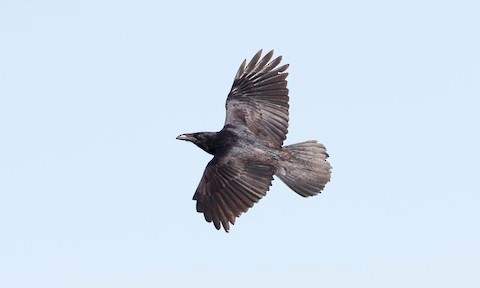
Common Raven, showing that the tail does not always appear wedge-shaped. (Summit Ledges, Hawk Ridge Nature Reserve, Minnesota; October 20, 2016.) © Brian Sullivan
Cf. Chihuahuan Raven. The Common Raven occurs in or near all of the Chihuahuan Raven’s range, so positive identification of Chichuahuan always entails distinguishing it from Common. They are extremely similar, essentially identical in shape, including a typically wedge-shaped tail and proportionately long wings, but Chihuahuan averages about 20-25% smaller in length measurements and less than half the weight of Common. The size difference is significant but very difficult to evaluate at a distance. Other differences that may help under some circumstances include:
Voice: Chihuahuan has a softer voice that lacks the distinctive rolling and resonant qualities of most Common Raven vocalizations.
Habits: Chihuahuan is a more social species that often occurs in large flocks, whereas Common tends to be solitary or occur in small groups.
Habitat: Chihuahuan tends to occur in scrub and partly wooded areas, whereas Common is usually in mountains or barren plains.
Neck Feathers: Chihuahuan was formerly known as White-necked Raven (also the name of a very different African species) because the bases of its neck feathers are white. This is concealed most of the time but occasionally revealed by wind or preening.
Nasal Bristles: Chihuahuan tends to grow longer nasal bristles that often extend well beyond the mid-point of the culmen. On Common, these feathers are usually shorter than the mid-point. This feature is useful in some cases but not completely reliable. These feathers are not always visible or fully grown, and Common’s can also extend past the mid-point.
Cf. Brown-necked Raven. Common and Brown-necked Ravens overlap narrowly from Morocco to Iraq. Brown-necked averages slightly smaller, but not enough to be useful in identification. The main differences are coloration and voice. More than its name suggests, Brown-necked is brownish over its head, neck, and breast, whereas adult Common is glossy-black. Immature Common often has approximately the same brownish coloration as Brown-necked, but it usually appears somewhat irregular and would rarely if ever be identical to Brown-necked’s pattern. Brown-necked’s voice lacks the rolling quality that is characteristic of most of Common’s calls.
Notes
Polytypic species consisting of eight recognized subspecies.
References
Alderfer, J., and J.L. Dunn. 2014. National Geographic Complete Birds of North America (Second Edition). National Geographic Society, Washington, D.C.
BirdLife International. 2017. Corvus corax (amended version of 2016 assessment). The IUCN Red List of Threatened Species 2017: e.T22706068A113271893. https://dx.doi.org/10.2305/IUCN.UK.2017-1.RLTS.T22706068A113271893.en. (Accessed January 22, 2021.)
Brazil, M. 2009. Birds of East Asia. Princeton University Press, Princeton, N.J.
eBird. 2021. eBird: An online database of bird distribution and abundance. Cornell Lab of Ornithology, Ithaca, N.Y. http://www.ebird.org. (Accessed January 22, 2021.)
Fagan, J., and O. Komar. 2016. Peterson Field Guide to the Birds of Northern Central America. Houghton Mifflin Harcourt, New York.
Garcia-del-Rey, E. 2011. Field Guide to the Birds of Macaronesia: Azores, Madeira, Canary Islands, Cape Verde. Lynx Editions, Barcelona.
Garcia-del-Rey, E. 2018. Birds of the Canary Islands. Christopher Helm, London.
Hollom, P.A.D., R.F. Porter, S. Christensen, and I. Willis. 1988. Birds of the Middle East and North Africa. T & AD Poyser, Calton, England.
Howell, S.N.G., and S. Webb. 1995. A Guide to the Birds of Mexico and Northern Central America. Oxford University Press, Oxford.
Johnson, S.R., and D.R. Herter. 1989. The Birds of the Beaufort Sea. BP Exploration (Alaska) Inc., Anchorage, Alaska.
Mullarney, K., L. Svensson, D. Zetterström, and P.J. Grant. 1999. Birds of Europe. Princeton University Press, Princeton, N.J.
Pyle, R.L., and P. Pyle. 2017. The Birds of the Hawaiian Islands: Occurrence, History, Distribution, and Status. Version 2 (January 1, 2017). http://hbs.bishopmuseum.org/birds/rlp-monograph/. B.P. Bishop Museum, Honolulu, Hawaii.
Salt, W.R., and J.R. Salt. 1976. The Birds of Alberta. Hurtig Publishers, Edmonton, Alberta.
Sibley, D.A. 2000. The Sibley Guide to Birds. Alfred A. Knopf. New York.
Xeno-Canto. 2021. Northern Raven – Corvus corax. https://www.xeno-canto.org/species/Corvus-corax. (Accessed January 22, 2021.)


